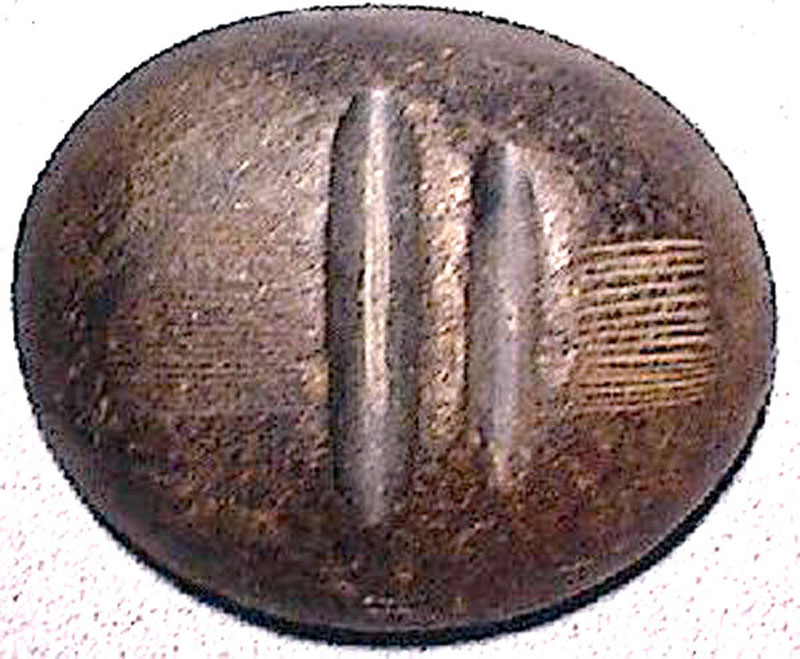|
|
Natural History Museum of Los Angeles County Collection
|
Tataviam twined water bottle. 9 inches wide, 5 inches tall. Diagonally twined (up to the right), juncus wefts and warps, alsphaltum coating, damaged, partially patched. Archaeological artifact collected by Richard F. Van Valkenburgh in the Piru Creek area (exact year and discovery site unknown, probably 1932-1936[1]), in the collection of the Natural History Museum of Los Angeles County, Catalog No. A.3306.36-64. The NHMLA catalog listing identifies it as Chumash, which it isn't, and says it's from "San Luis Obispo-Piru Canyon," which makes no sense. Shanks and Shanks (2010) illustrate this basket in their book on Southern California basketry[2] and state the following in the photo caption (pg. 52): A handsome, broad-shouldered Tataviam twined water bottle. No other culture made water bottles quite like this one. This very distinctively shaped archaeological basket is largely woven in diagonal twining with an asphaltum coating. At page 56 (ibid.): In the Natural History Museum of Los Angeles County there are archaeological basketry specimens collected by Richard Van Valkenburgh from Piru Creek in Tataviam territory. The most complete twined basket is a distinctive low, broad bottleneck-shaped water bottle approximately nine inches in diameter and five inches high at the neck (A.3306.36-64). This finely made, although damaged, water bottle is diagonally twined with some asphaltum coating. An impressive decorative feature consists of several rows of diagonal stitching over multiple warps on the basket's shoulder and bottom. Wefts have an up-to-the-right slant of weft twist, as do most other twined fragments in the Tataviam region. This Piru Creek Tataviam twined water bottle, in particular, is unlike neighboring Chumash or Gabrielino/Tongva water bottles and almost certainly is Tataviam. Shanks and Shanks say that while up-to-the-right slants are most common among Tataviam twined basketry, both up-to-the-right and down-to-the-left slants are known (which is rather unusual); and plain twining (no slant) is also known. The authors reference a probable Tataviam twined basket fragment in the NHMLA collection that has a horizontal section with two crossed open spaced warps amid close plain twining. As a general rule, not limited to the Tataviam, twined baskets are utilitarian and are seldom decorated; coiled basketry is fancier. Coiled basketry is known among the Tataviam, but decorated coiled Tataviam basketry is rare. 1. Van Valkenburgh explored and recovered artifacts from several caves in the Piru Creek drainage area from 1932-1936 on behalf of the Natural History Museum of Los Angeles County; see Lopez (1974). 2. The Tataviam chapter was read prior to publication by Dr. John Johnson of the Santa Barbara Natural History Museum.
Images from the Natural History Museum of Los Angeles County; Catalog No. A.3306.36-64. |
Bowers Cave Specimens (Mult.)
Bowers on Bowers Cave 1885
Stephen Bowers Bio
Bowers Cave: Perforated Stones (Henshaw 1887)
Bowers Cave: Van Valkenburgh 1952
• Bowers Cave Inventory (Elsasser & Heizer 1963)
Tony Newhall 1984
• Chiquita Landfill Expansion DEIR 2014: Bowers Cave Discussion
Vasquez Rock Art x8
Ethnobotany of Vasquez, Placerita (Brewer 2014)
Bowl x5
Basketry Fragment
Blum Ranch (Mult.)
Little Rock Creek
Grinding Stone, Chaguayanga
Fish Canyon Bedrock Mortars & Cupules x3
2 Steatite Bowls, Hydraulic Research 1968
Steatite Cup, 1970 Elderberry Canyon Dig x5
Ceremonial Bar, 1970 Elderberry Canyon Dig x4
Projectile Points (4), 1970 Elderberry Canyon Dig
Paradise Ranch Earth Oven
Twined Water Bottle x14
Twined Basketry Fragment
Grinding Stones, Camulos
Arrow Straightener
Pestle
Basketry x2
Coiled Basket 1875
Riverpark, aka River Village (Mult.)
Riverpark Artifact Conveyance
Tesoro (San Francisquito) Bedrock Mortar
Mojave Desert: Burham Canyon Pictographs
Leona Valley Site (Disturbed 2001)
2 Baskets
So. Cal. Basket
Biface, Haskell Canyon
2 Mortars, 2 Pestles, Bouquet Canyon
|
The site owner makes no assertions as to ownership of any original copyrights to digitized images. However, these images are intended for Personal or Research use only. Any other kind of use, including but not limited to commercial or scholarly publication in any medium or format, public exhibition, or use online or in a web site, may be subject to additional restrictions including but not limited to the copyrights held by parties other than the site owner. USERS ARE SOLELY RESPONSIBLE for determining the existence of such rights and for obtaining any permissions and/or paying associated fees necessary for the proposed use.


































